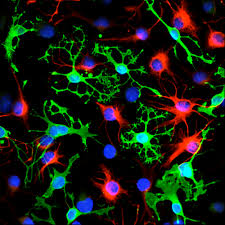Neuroscientist Gregor Pilz of the University of Zurich has watched stem cells turn into neurons in the brains of young, living mice—a feat that not too long ago was considered impossible. His latest experiments add to those earlier observations, showing that mice have yet another population of self-renewing stem cells in their brains and some of those cells are much longer-lived than the first ones he documented. If confirmed, the result, which Pilz discussed today (October 22) at the Society for Neuroscience meeting in Chicago, could help reveal what happens to neurogenesis—the generation of new neurons—as animals age.
Past studies have identified different populations of neural stem cells but tracking what happens to them in the brains of living mice over time has been difficult. The part of the hippocampus where these cells exist, called the dentate gyrus, is deeper in the brain, so scientists would have to remove tissue above it to be able to observe the neural stem cells in living mice, and they would need tracers to mark the specific stem cells they want to watch.
In a 2018 Science paper, Pilz, a postdoc in Sebastian Jessberger’s lab at Zurich, and colleagues described how they did this to monitor the cell division of neural stem cells marked by Ascl1–driven expression of green fluorescent protein. The Ascl1 protein plays a role in neural differentiation. Those stem cells undergo “rapid neurogenetic bursts,” giving rise to an average of five neurons in two months or less before disappearing from the mice’s brains, the researchers reported.
By comparison, some of the neural stem cells Pilz and his colleagues tracked in their latest experiments are relatively longer-lived. These cells, marked by the Gli1-driven expression of the fluorescent protein tdTomato, give rise to five neurons over the course of up to 90 days before disappearing. The Gli1 protein also plays a role in neurogenesis. The result shows there’s a “kind of diversity” in the neural stem cells in the dentate gyrus, Pilz tells The Scientist. His team’s work is also starting to reveal details about the molecular and cellular differences that drive how long neural stem cells survive once they start dividing and could also give clues to the cellular mechanisms that underlie the decline in levels of neurogenesis during aging.
Pilz notes that the team was studying young adult mice in the latest experiments, so he says the technique has allowed the team to begin to trace the fate of the different stem cell populations it has been tracking as the mice age. Those experiments, he says, could reveal if aging detrimentally affects the lineages. The team can also now watch what happens to the stem cell and new neuronal populations when the animals exercise or socialize—both of which are correlated to increased neurogenesis in adult mice.
The results could identify the “physiological conditions that actually help neurogenesis, activate the stem cells, or support the survival of neurons,” Pilz says.







